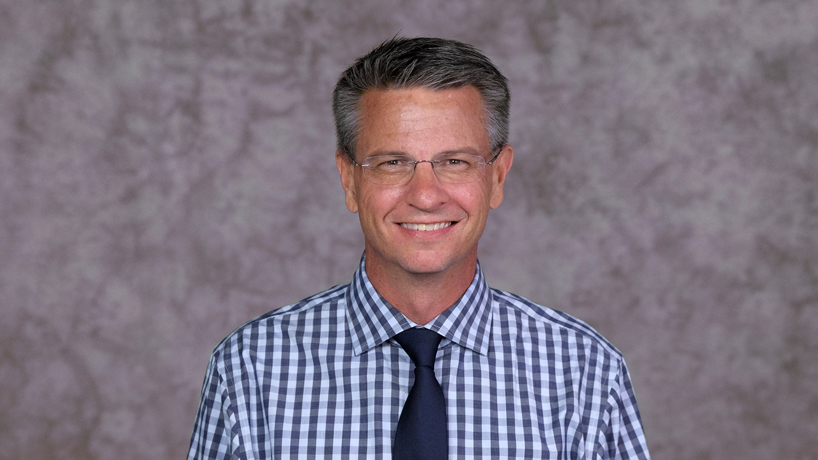
Robert Paul, the director of the Missouri Institute of Mental Health, is the recipient of the 2016 Chancellor’s Award for Excellence in Research and Creativity. (Photo by August Jennewein)
Robert Paul was a young graduate student in biological psychology, observing the chaotic lives of faculty researchers at the University of Oklahoma Health Sciences Center whenever it came time to secure grants to fund their work.
Paul, now the director of the Missouri Institute of Mental Health and the 2016 recipient of the Chancellor’s Award for Excellence in Research and Creativity, had one recurring – and today surprising – thought.
“I think I want to be a clinician,” he recalled recently while sitting in his office in Innovative Technology Enterprises at University of Missouri–St. Louis.
Paul studied clinical psychology at Oklahoma State University while simultaneously earning his PhD in biological psychology and neuropsychology from the Oklahoma Health Sciences Center. He underwent training at Brown University’s Alpert Medical School and later had appointments as the staff psychologist at The Miriam Hospital and Butler Hospital, both in Rhode Island.
But even then, he could never walk away from working in the lab.
“The questions that you want to ask are just in you, so you can’t really get rid of them,” Paul said of what has drawn him to research. “It’s kind of like being a little kid because you just get to ask questions all day long. People pay you to ask questions and try to find the answers to them.”
He added: “I love to go to work. You get this natural passion to go after these really big, hairy questions that we don’t know the answers to and try to tackle them.”
Paul’s research is focused on mechanisms of brain dysfunction in health conditions that primarily impact brain structures located deep beneath the surface of the cerebral cortex.
It’s a field of study that that has taken off with technological advancements in neuroimaging over the past 25 years.
“Historically, we haven’t learned very much about those areas of the brain because you couldn’t see them,” Paul said. “You needed advanced technology to really understand how those deep regions of the brain were working and not working in certain conditions.”
He and his research team have developed specific expertise exploring the impact of three conditions – human immunodeficiency virus (HIV), subcortical stroke and early life trauma – have on the integrity of deep brain structures, including the white matter, basal ganglia and limbic structures.
“The brain in HIV has become a really interesting area of research because it is a prominent aspect of the disease,” Paul said. “If you don’t have healthy brain function, you’ll forget to take your meds. If you forget to take your meds, you’ll fail on therapy.”
Paul has been involved in active research programs in South Africa, Thailand, Vietnam, and Cambodia and works closely with collaborators at Brown; University of California, San Francisco; Yale University; Washington University in St. Louis; and Missouri University of Science & Technology.
He has had great success securing millions of dollars in prestigious R01 grants from the National Institutes of Health.
He’s also been a prolific publisher, contributing to more than 235 manuscripts, two edited books and more than a dozen book chapters.
“Dr. Paul always has the ‘can do attitude’ and is willing to think outside of the box,” said Beau Ances, a member of the department of neurology at Washington University, while writing in support of Paul’s nomination for the Chancellor’s Award. “He has a unique ability to critically assess an issue and find solutions to often complex issues that have plagued the field.”
“Dr. Paul is one of the most collaborative individuals I’ve had the privilege to work with,” wrote Victor Valcour, a professor in the neurology department at the UCSF. “He presents ideas without consideration for personal gain. We have never struggled with issues such as authorship, often each choosing to lead from behind and allowing junior investigators to take the first authorship position.
“He is creative and innovative, providing thoughtful ideas for new projects and directing means by which we can best understand and treat HIV-infected populations who suffer from cognitive disorders. His role in advancing my research program has far exceeded my expectations.”
Paul is held in high regard not just by peers but also by students who have worked under and learned from him.
“Dr. Paul’s commitment to his students is unmatched,” wrote Robert Graziano, a graduate student studying clinical psychology at UMSL. “Every student in his lab is expected to work toward a larger, group goal, yet within those goals individual student milestones are placed. These milestones are constantly bolstered by the individual attention every student receives as Dr. Paul spends countless hours patiently working on an individual basis to promote his students to become the best version of themselves.”
Paul was unaware of the role they and others played in nominating him for the Chancellor’s Award, one of six faculty awards in different categories that will be presented Sept. 14 at UMSL’s annual State of the University Address. With it comes a $1,000 honorarium.
He had not been seeking recognition, but it was appreciated.
“That’s why I’m here is to try to stimulate new research and really bring to fruition ideas that are new and creative and impactful,” Paul said. “When that’s recognized by your peers on campus, that’s really special.”
Paul left Brown’s medical school to join the UMSL faculty in 2006. His move to the Midwest was motivated, in part, by the access it gave him to imaging technology at Washington University for his research.
UMSL also has proved to be an ideal environment for him to work.
“UMSL for me was and still is about culture, and the culture of collegiality,” he said. “It’s not a culture of competition between faculty that is so significant that people try to undermine one another. People generally, they’re nice. If you ask for help, someone will help you, and there are really, really competent people in their fields that don’t have big egos. That is what makes it an ideal place to work.”














